The Chuwi AeroBook Review: One Small Step For Chuwi
by Brett Howse on June 21, 2019 8:00 AM ESTGPU Performance
With just a 4.5-Watt Thermal Design Power for the entire SoC inside the Chuwi AeroBook, graphics demands are going to be a challenge, but if we compare the AeroBook to the previous Chuwi models, there’s still a substantial increase in raw performance available.
The Core m3-6Y30 features the Intel HD 515 graphics, which is several generations behind Intel’s latest, but the differences are minor since they’ve not really refreshed their GPU architecture for some time. The big difference between the HD 515 and the UHD 600 found in the latest Gemini Lake SoC Chuwi had leveraged before is that the HD 515 features 24 execution units compared to just 12 in the Celeron N4100. The HD 515 in the Core m3-6Y30 also has a higher Turbo frequency for the GPU – up to 850 MHz – compared to just 700 MHz on the N4100.
Still, as we’ve seen many times before, even with more TDP available, the integrated GPU on the Intel CPUs is really showing its age. To see how the Chuwi AeroBook performs, it was run through our Ultrabook GPU suite, which consists of a couple of synthetic tests, and one game which can be playable on an iGPU. We’ll see how the Chuwi performs though, and Chuwi’s decision to use single-channel RAM is likely to hurt the GPU scores the most.
3DMark

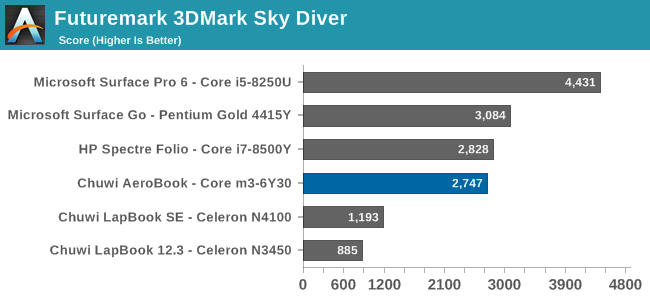
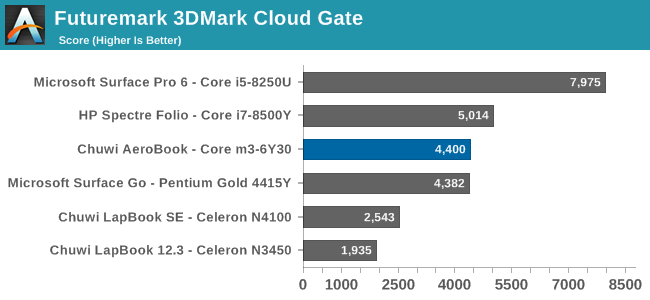
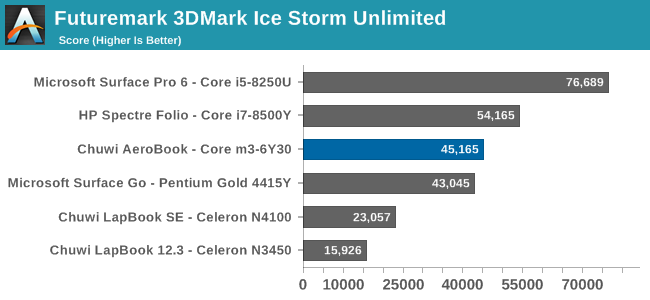
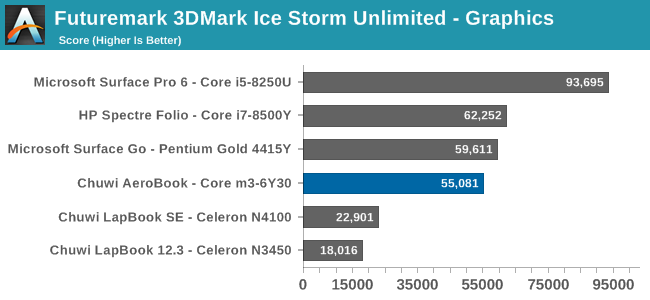

UL’s 3Dmark offers several tests of varying complexity, all the way from Ice Storm Unlimited which can be run on a smartphone, up to Fire Strike which can challenge even the latest GPUs. This test instantly shows the gap between the Atom powered Celerons and the Core powered devices, and even though none of these are powerful GPUs, even at a 5-Watt TDP the Core m3 offers double the performance of the Celeron.
GFXBench

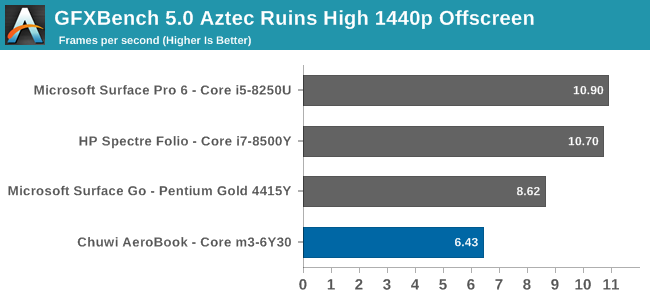
The latest Aztec Ruins test from Kishonti finally dumps OpenGL on the PC and offers DX12. Unfortunately the older Atom powered devices weren’t tested on this newer benchmark, but it does show the detriment that single-channel RAM plays since the Chuwi is the only device in the graph to not offer dual-channel memory.
Dota 2
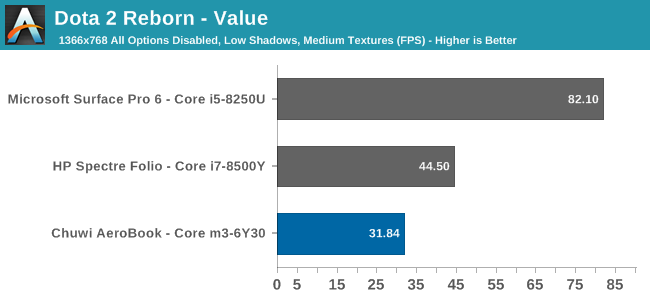
Valve’s Dota 2 continues to be our real-world game of choice for low-end devices because the game is one of the few that is actually playable even on an integrated GPU. Unfortunately the Chuwi is barely playable even at our lowest tested settings. The single-channel RAM is certainly a big factor, as is likely the lower CPU performance, since Dota 2 can be a CPU limited game as well.
GPU Summary
The move from Atom to Core brings with it a much larger GPU, and that improvement is clearly demonstrated in our results, but Chuwi’s decision to go with single-channel RAM definitely hurts overall performance. Intel’s integrated GPU really needs an update though, since even properly equipped and with a 15-Watt TDP like on the Surface Pro 6, it still struggles to offer much in the way of performance.
Storage Performance
Chuwi has also made a step up in storage. On most of their other low-end notebooks, they tend to offer eMMC storage, and although they generally offer more flash storage at the same price point as their competitors, eMMC doesn’t offer the performance of a SSD. The Chuwi AeroBook which is sold in North America comes with a single storage offering, and that is a 256 GB SSD, and in this case it’s a Netac model. Chuwi has offered a SSD before, but not as the boot drive, so this is a welcome change.
The performance is not fantastic, but still a step beyond what eMMC offers. The SSD is also accessible on the bottom of the notebook by removing two screws, so if you want to swap in a larger SATA SSD, it’s possible, which isn’t the case on most Ultrabooks without a lot of deconstruction.


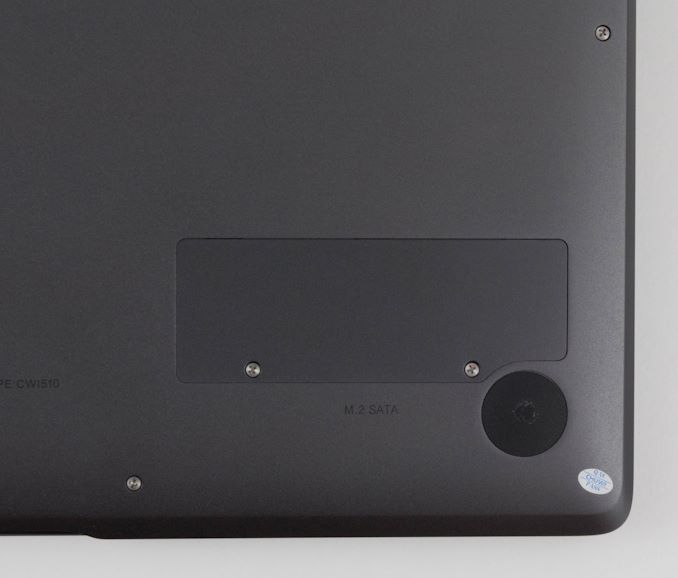
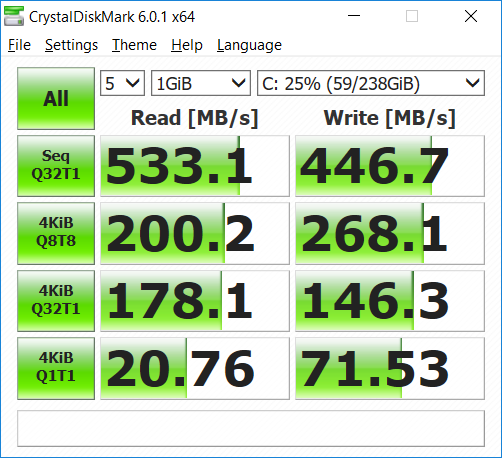








51 Comments
View All Comments
HStewart - Friday, June 21, 2019 - link
I have purchase a Chuwi tablet and would say it was very cheap and I would never purchase one for $500. This uses 2 generations old bottom of line Intel Y processor and very soon to 3 generations old. My guess is that they are trying to monopolize on old hardware.My 3 year old Samsung TabPro S has similar cpu and in better form factor than this - are we sure this was a new computer - but than again Chuwi always used outdated components which to be honest gives a bad name out there.
pjcamp - Friday, June 21, 2019 - link
"Chuwi has often never done well on battery life..."Often never?
PixyMisa - Sunday, June 23, 2019 - link
In this case, yes.Hog54 - Friday, June 21, 2019 - link
Im on a Asus laptop that has a AMD RYZEN 2500u, Nvidia 1050 graphics,8 gig of ram,and a 256 ssd that I paid the same price for 3 months ago.:)Xpl1c1t - Saturday, June 22, 2019 - link
Bought a Huawei Ryzen 2500U Matebook D, $450. Im mainly a desktop user, but this laptop is probably the most functional laptop I've used. Running Plasma Wayland desktop for most taks (still need windows for MATLAB and SPICE). Havent been this convinced that I own a great mobile product since purchasing the Samsung NC20 (Via Nano powered) netbook ages ago and reworking the keyboard to DVORAK to evaluate the claimed benefits (it is better, wish i could rework this keyboard).The level of competition in the low/midrange mobile segment makes me wonder why anyone would mess with premium segment mobile products given the minimal performance gap. Egotism I guess.
HP, Razer, Dell, Apple - I see most college students around me using these products, but cant help shaking my head when considering their markup over price-competitive brands. My experience with HP laptops is that they have fragile glass coverings on their touchscreens, Razer is basically adopting the premium Apple tax mentality which caters to their market segments, Dell products are probably the most durable - though XPS machines are way overpriced. I strongly suspect that, despite the fact that all these machines are not manufactured domestically, that the markup over identically specc'd machines from non-domestic brands is simply buffering the inevitable collapse of their niche domestic markets. The proposition that the domestic engineering of a laptop is significantly superior to non-domestic engineering is no longer legitimate. Guess this is why people want to make america great again?
bji - Saturday, June 22, 2019 - link
I guess no one else is as smart as you huh?Perhaps you should read and understand the selection mechanisms that go into consumer choices. Not everyone wants what you want, and other people value aspects of products that you may not care about. It's kind of obvious if you think about it. Have you actually thought about it? Or are you more comfortable making ego-stroking assumptions?
Sorry I just cannot read another smug Anandtech post about how much smarter the poster is than everyone else with regards to product choices. It is soooo old and increasingly annoying every time it happens.
Xpl1c1t - Sunday, June 23, 2019 - link
I'm not proposing that I am smart, but thank you for educating me about your opinion."The proposition that the domestic engineering of a laptop is significantly superior to non-domestic engineering is no longer legitimate."
That is my proposal. Eat it. What, do you work for HP? Raking in the screen repair bucks? Yeah... guess I cant get my Huawei repaired domestically, but im not concerned about the glass shattering any time soon.
oRAirwolf - Sunday, June 23, 2019 - link
I got one of these off of the IndieGoGo campaign for $429. It's a nice laptop for the money. I agree that the battery is too small.Some complaints:
The screen has a very yellow tint to it. I have tried adjusting the color temp in the Intel control panel, but it's just not great. I ordered a SpyderX Pro and am going to play with it more.
The backlight on the keyboard does not turn on with the laptop. You have to turn it on every time you power on the laptop. It would be really nice if it remembered it's setting.
The backlight on the keyboard does not turn off when you turn off the laptop.
The BIOS is completely unlocked and has options for many features that do not exist. It makes it pretty difficult to make any changes.
Lord of the Bored - Monday, June 24, 2019 - link
"The backlight on the keyboard does not turn off when you turn off the laptop."All I can say to that is: Haha what.
...
How do you mess that up?
Spunjji - Wednesday, June 26, 2019 - link
Agreed, that's pretty damn special!